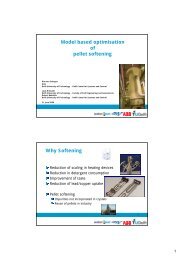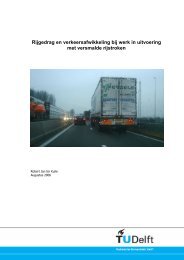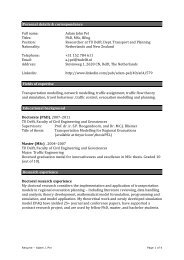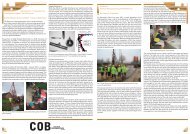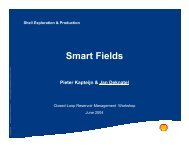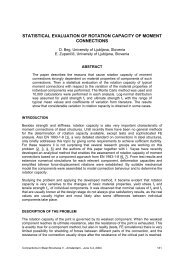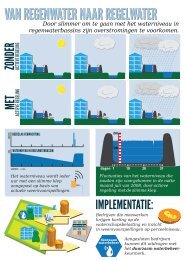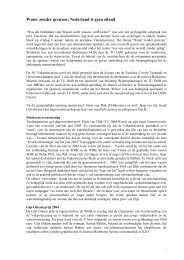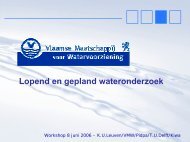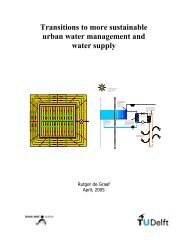Pedestrian route-choice and activity scheduling theory and models
Pedestrian route-choice and activity scheduling theory and models
Pedestrian route-choice and activity scheduling theory and models
Create successful ePaper yourself
Turn your PDF publications into a flip-book with our unique Google optimized e-Paper software.
188 S.P. Hoogendoorn, P.H.L. Bovy / Transportation Research Part B 38 (2004) 169–190<br />
<strong>theory</strong> by applying an optimal control approach or the <strong>theory</strong> of differential games. This yields<br />
closed form expressions describing how pedestrians react to other pedestrians in their direct environment.<br />
8. Model applications<br />
The approach describes pedestrian <strong>activity</strong> <strong>scheduling</strong> <strong>and</strong> <strong>route</strong> <strong>choice</strong> for different types of<br />
pedestrians with distinct perceptions of <strong>route</strong> attributes. Contrary to network-based approaches,<br />
<strong>route</strong>s are continuous in time <strong>and</strong> space. Applications of the model are manifold. For one, the<br />
approach is used to model <strong>choice</strong> behavior in the pedestrian microsimulation model NOMAD<br />
(Hoogendoorn, 2001). St<strong>and</strong>-alone applications of the model are however also possible to predict<br />
<strong>route</strong> <strong>choice</strong> in infrastructure facilities, such as transfer stations <strong>and</strong> shopping malls. For planning<br />
purposes, dynamic user-equilibrium solutions of the pedestrian assignment problem can be used<br />
to forecast pedestrian flows. Such predictions are valuable to reveal bottlenecks in infrastructure<br />
design, to predict average transfer times (walking time from egress to access locations, given<br />
expected traffic conditions), or the optimal location of a ticket machine or newspaper st<strong>and</strong>. For<br />
instance, the Schiphol Plaza example shows which vendor location is preferable from the viewpoint<br />
of passing pedestrian flows, given pedestrian origin-<strong>activity</strong> dem<strong>and</strong>s. This way, infrastructure<br />
design, platform allocation, time tables, etc. can be optimized. This pertains to regular<br />
circumstances, as well as to emergency conditions (albeit different <strong>models</strong> are required to describe<br />
walking operations). Practical application of the <strong>models</strong> will require calibration (<strong>and</strong> validation)<br />
of the model. This can be done by considering previous empirical studies showing the relative<br />
importance of different <strong>route</strong> attributes for varying trip purposes, <strong>and</strong> subsequently estimating the<br />
relevant weights. Comparing (qualitatively) the resulting path flows <strong>and</strong> speeds with observations<br />
reveals whether changes in the weights are needed. Given the fact that distance (or travel time) is<br />
the most important <strong>route</strong> attribute, we expect that model calibration is relatively straightforward,<br />
at least for distinct groups of pedestrians (e.g. commuters).<br />
9. Summary <strong>and</strong> future research<br />
This article puts forward a new <strong>theory</strong> based on the assumption that pedestrians are subjective<br />
utility maximizers: they schedule their activities, the <strong>activity</strong> areas, <strong>and</strong> the paths between the<br />
activities (which, on the contrary to other transportation networks, are continuous functions in<br />
time <strong>and</strong> space) simultaneously to maximize the predicted utility of their efforts <strong>and</strong> walking. The<br />
utility reflects a trade-off between the utility of completing an <strong>activity</strong>, <strong>and</strong> the cost of walking<br />
towards the <strong>activity</strong> areas. In turn, the latter results from different factors, such as the travel time,<br />
discomfort of walking too close to obstacles <strong>and</strong> walls, stimulation of the environment, etc.<br />
Uncertainty pertaining to the predictability of the future conditions is included by assuming that<br />
the predicted <strong>route</strong>s are realizations of r<strong>and</strong>om processes. The effect of prevailing traffic conditions<br />
on pedestrian <strong>choice</strong> behavior have been considered as well. To operationalize the <strong>theory</strong>,<br />
different techniques from stochastic mathematical optimal control <strong>theory</strong> have been applied<br />
successfully. The different concepts have been illustrated by examples.



